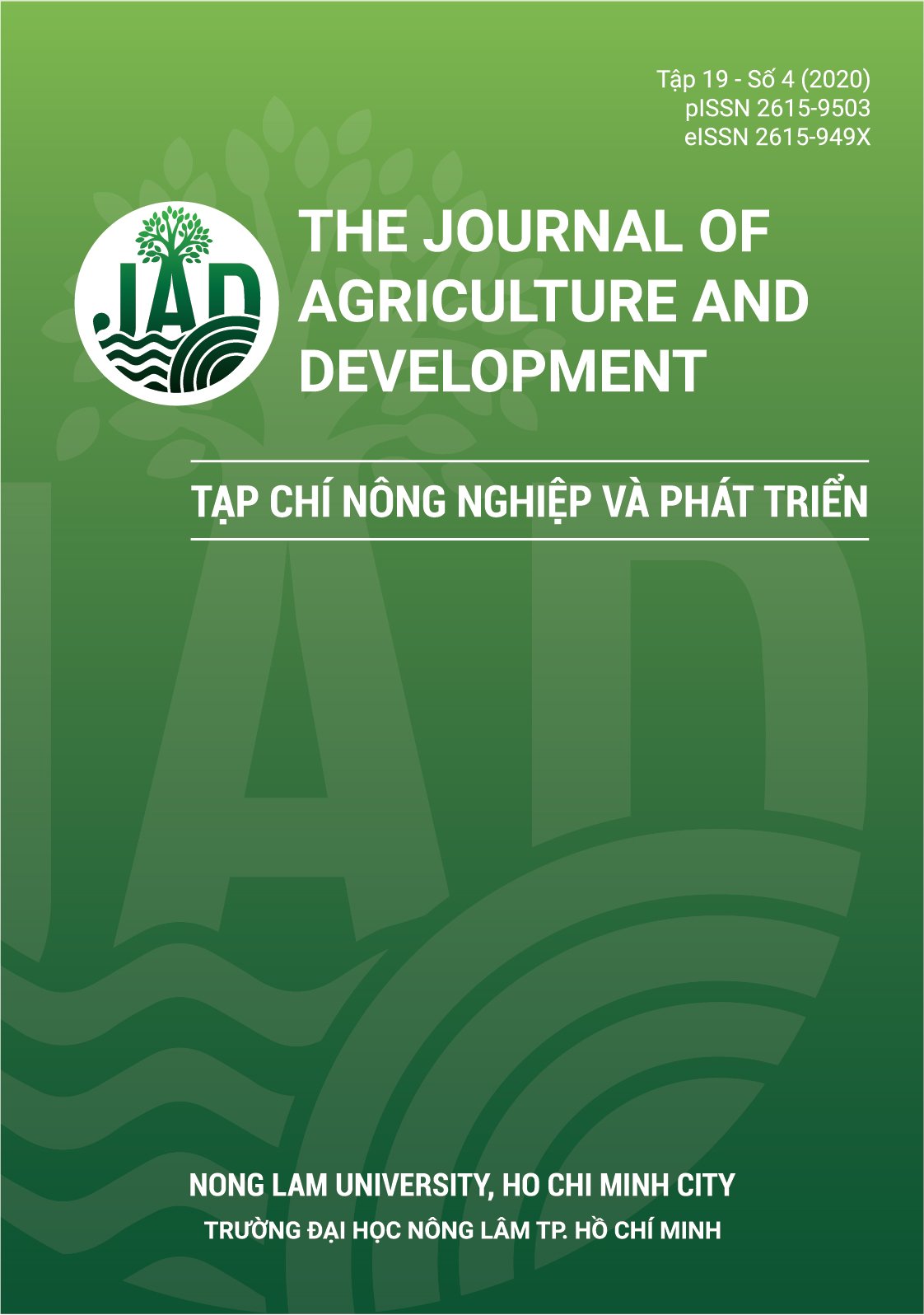Khảo sát các yếu tố ảnh hưởng đến phản ứng thủy phân sụn khớp chân gà với xúc tác enzyme Protamex
Main Article Content
Tóm tắt
Nghiên cứu này được tiến hành với mục đích thủy phân sụn khớp chân gà với xúc tác enzyme Protamex nhằm thu axit amin. Thành phần hóa học của sụn khớp chân gà được phân tích, kết quả phân tích cho thấy hai thành phần chính trong chất khô của sụn khớp chân gà là lipid (19,72 ± 0,05%) và protein (13,34 ± 0,08%). Các yếu tố chính ảnh hưởng đến phản ứng thủy phân sụn khớp chân gà với xúc tác enzyme Protamex được lựa chọn để khảo sát: Nhiệt độ phản ứng (°C), pH môi trường phản ứng, tỉ lệ enzyme (%, dựa trên cơ chất), thời gian phản ứng (phút) và tỉ lệ thể tích môi trường phản ứng (v/v). Phân tích sự khác biệt có ý nghĩa được tiến hành với phương pháp ANOVA One-Way nhằm lựa chọn điều kiện tốt nhất cho phản ứng thủy phân. Hiệu suất thủy phân và hiệu suất thu nhận axit amin đạt giá trị lớn nhất lần lượt là 22,93 ± 4,01% và 30,25 ± 1,86% khi nhiệt độ phản ứng; pH môi trường phản ứng; tỉ lệ enzyme; thời gian phản ứng và tỉ lệ thể tích môi trường phản ứng thích hợp lần lượt là 40°C; 4; 0,52%; 40 phút và 1/18 (v/v).
Article Details
Tài liệu tham khảo
Araújo, Í. B. D. S., Bezerra, T. K. A., Nascimento, E.S. D., Gadelha, C. A. D. A., anti-Gadelha, T., & Madruga, M. S. (2018). Optimal conditions for obtain- ing collagen from chicken feet and its characterization. Food Science and Technology 38(Suppl. 1), 167-173. https://doi.org/10.1590/fst.27517
Bui, C. V., Bui, X. D., & Dang, M. N. (2020). Study on hydrolysis reaction of chicken cartilage using enzyme papain. Vietnam Trade and Industry Review 41, 29- 32.
Bui, C. V., Nguyen, M. N. T., Bui, D. X., & Tran, T.V. T. (2018). Screening for optimal parameters of hydrolysis reaction of red meat of Sadar Orientalis with NaOH as a catalyst to obtain protein hydrolysis solution. Journal of Fisheries Science and Technology 2, 16-23.
Bui, C. V., Nguyen, M. N. T., Nguyen, Q. V., Bui, D. X.,& Pham, M. T. (2019). Study on hydrolysis reaction of chicken cartilage using Falvourzyme. UED - Journal of Social Sciences, Humanities Education 9(4), 1-6. https://doi.org/10.47393/jshe.v9i4.106
Bui, D. X., Bui, C. V., Ngo, N. B. T., Pham, T. V.,& Pham, M. T. (2017). Research on the suitable pa- rameters for hydrolysis reaction of red meat of striped tuna (Sarda orientalis) by using commercial protamex. Vietnam Journal of Science and Technology 55(5A), 108-115. https://doi.org/10.15625/2525-2518/55/5A/12185
Horwitz, W. (2010). Official methods of analysis of AOAC International. Agricultural chemicals, contaminants, drugs (Volume I). Maryland, USA: AOAC In- ternational.
Jayathilakan, K., Sultana, K., Radhakrishna, K., & Bawa,A. S. (2012). Utilization of byproducts and waste ma- terials from meat, poultry and fish processing industries: a review. Journal of Food Science and Technology 49(3), 278-293. https://doi.org/10.1007/s13197-011-0290-7
Liaset, B., Julshamn, K., & Espe, M. (2003). Chemical composition and theoretical nutritional evaluation of the produced fractions from enzymatic hydrolysis of salmon frames with ProtamexTM. Process Biochemistry 38(12), 1747-1759. https://doi.org/10.1016/S0032-9592(02)00251-0
Luo, X. M., Fosmire, G. J., & Leach, R. M. (2002). Chicken keel cartilage as a source of chondroitin sulfate. Poultry Science 81(7), 1086-1089. https://doi.org/10.1093/ps/81.7.1086
Mangino, E. (2019). AS/Canada projects slightly slower growth in Canadian chicken meat production for 2020. GAIN Report Number: CA19029. Retrieved April 1, 2020, from https://apps.fas.usda.gov/newgainapi/api/report/downloadreportbyfilename?filename=Poultry%20and%20P roducts%20Annual_Ottawa_Canada_8-29-2019.pdf
Meeker, D. L. (2006). Essential Rendering - All about the animal by-products industry. Virginia, USA: Nationalenderers Association.
Nakano, T., & Sim, J. S. (1995). A study of the chemical composition of the proximal tibial articular cartilage and growth plate of broiler chickens. Poultry Science 74(3), 538-550. https://doi.org/10.3382/ps.0740538
Nguyen, H. T. M., Sylla, K. S. B., Randriamahatody, Z., Donnay-Moreno, C., Moreau, J., Tran, L. T., & Bergé,mJ. P. (2011). Enzymatic hydrolysis of yellowfin tuna (Thunnus albacares) by-products using Protamex protease. Food Technology and Biotechnology 49(1), 48-55.
Pope, C. G., & Stevens, M. F. (1939). The determination of amino-nitrogen using a copper method. Biochemical Journal 33(7), 1070-1077. https://doi.org/10.1042/bj0331070
Seyer, J. M., Brickley, D. M., & Glimcher, M. J. (1974). The identification of two types of collagen in the articular cartilage of postnatal chickens. Calcified Tissue Research 17(1), 43-55. https://doi.org/10.1007/BF02547213
Thureen, P. J. (2012). Neonatal nutrition and metabolism. Cambridge, UK: Cambridge University Press.
Wisuthiphaet, N., Klinchan, S., & Kongruang, S. (2016). Fish protein hydrolysate production by acid and enzymatic hydrolysis. International Journal of Applied Science and Technology 9(4), 261-270.








